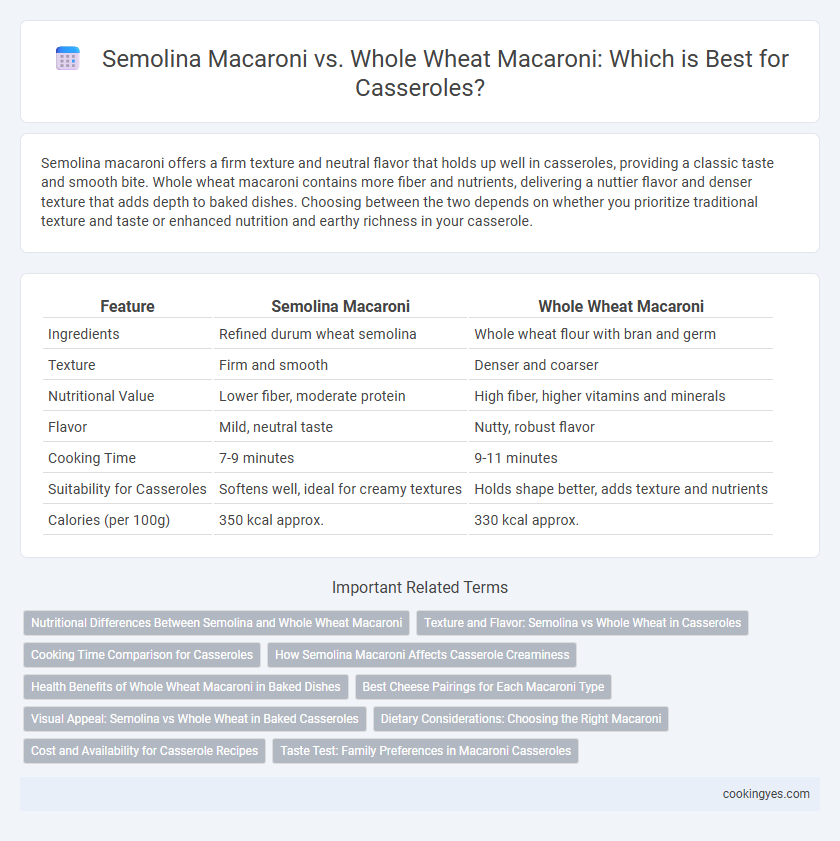Semolina macaroni offers a firm texture and neutral flavor that holds up well in casseroles, providing a classic taste and smooth bite. Whole wheat macaroni contains more fiber and nutrients, delivering a nuttier flavor and denser texture that adds depth to baked dishes. Choosing between the two depends on whether you prioritize traditional texture and taste or enhanced nutrition and earthy richness in your casserole.
Table of Comparison
| Feature | Semolina Macaroni | Whole Wheat Macaroni |
|---|---|---|
| Ingredients | Refined durum wheat semolina | Whole wheat flour with bran and germ |
| Texture | Firm and smooth | Denser and coarser |
| Nutritional Value | Lower fiber, moderate protein | High fiber, higher vitamins and minerals |
| Flavor | Mild, neutral taste | Nutty, robust flavor |
| Cooking Time | 7-9 minutes | 9-11 minutes |
| Suitability for Casseroles | Softens well, ideal for creamy textures | Holds shape better, adds texture and nutrients |
| Calories (per 100g) | 350 kcal approx. | 330 kcal approx. |
Nutritional Differences Between Semolina and Whole Wheat Macaroni
Semolina macaroni, made from refined durum wheat, is higher in gluten and has a finer texture but lacks the fiber content found in whole wheat macaroni, which contains bran and germ components. Whole wheat macaroni offers increased dietary fiber, essential vitamins like B-complex, and minerals such as magnesium and zinc, promoting better digestion and sustained energy release in casseroles. Choosing whole wheat macaroni enhances the nutritional profile of casseroles by providing antioxidants and improving heart health compared to the more processed semolina variety.
Texture and Flavor: Semolina vs Whole Wheat in Casseroles
Semolina macaroni offers a firm, slightly al dente texture with a mild, nutty flavor that enhances the creamy sauces typical in casseroles. Whole wheat macaroni provides a denser, chewier bite and a robust, earthy flavor that adds depth but can sometimes overpower delicate ingredients. Choosing semolina ensures a smooth, consistent texture while whole wheat introduces a hearty, fibrous component ideal for rustic casserole recipes.
Cooking Time Comparison for Casseroles
Semolina macaroni typically cooks faster in casseroles, requiring about 12-15 minutes to achieve an optimal texture, whereas whole wheat macaroni needs 15-20 minutes due to its denser fiber composition. Whole wheat macaroni provides a nuttier flavor and higher nutritional value but demands longer simmering to soften completely in baked dishes. Choosing between semolina and whole wheat macaroni for casseroles depends on balancing cooking time with desired texture and health benefits.
How Semolina Macaroni Affects Casserole Creaminess
Semolina macaroni, made from durum wheat, has a coarse texture that absorbs liquid differently than whole wheat macaroni, enhancing casserole creaminess by releasing starch gradually during baking. This slow starch release helps maintain a smooth, silky sauce, preventing separation or dryness in the casserole. Whole wheat macaroni tends to absorb more liquid quickly, which can result in a drier, less creamy texture in casseroles.
Health Benefits of Whole Wheat Macaroni in Baked Dishes
Whole wheat macaroni offers higher fiber content and essential nutrients like iron and magnesium compared to semolina macaroni, promoting better digestion and heart health in baked casseroles. Its lower glycemic index helps maintain steady blood sugar levels, making it a healthier choice for diabetic-friendly meals. Incorporating whole wheat macaroni into casseroles enhances nutritional value without compromising taste or texture.
Best Cheese Pairings for Each Macaroni Type
Semolina macaroni, made from refined durum wheat, pairs exceptionally well with sharp cheddar, Parmesan, and aged Gouda, as their bold flavors complement its firm texture and slightly nutty taste. Whole wheat macaroni, richer in fiber and nutrients, harmonizes best with milder cheeses like mozzarella, creamy ricotta, and fresh goat cheese, which enhance its earthier, heartier profile. For casseroles, choosing the right cheese enhances the overall flavor; semolina macaroni's robust bite is elevated by stronger cheeses, while whole wheat benefits from softer, creamier varieties that balance its wholesome taste.
Visual Appeal: Semolina vs Whole Wheat in Baked Casseroles
Semolina macaroni offers a bright golden-yellow hue that enhances the visual appeal of baked casseroles, creating an inviting and vibrant presentation. Whole wheat macaroni, with its darker, earthier tone, delivers a rustic and hearty appearance but can result in a less vivid casserole surface. Choosing semolina pasta prioritizes a visually striking dish, while whole wheat appeals to a more natural, wholesome aesthetic.
Dietary Considerations: Choosing the Right Macaroni
Semolina macaroni, made from refined durum wheat, offers a firm texture ideal for casseroles but contains less fiber compared to whole wheat macaroni, which provides increased dietary fiber and essential nutrients beneficial for digestive health. Whole wheat macaroni is richer in vitamins, minerals, and antioxidants, making it a better choice for those seeking heart-healthy options or improved glycemic control. Choosing between semolina and whole wheat macaroni depends on balancing texture preferences with dietary goals related to fiber intake and nutritional value.
Cost and Availability for Casserole Recipes
Semolina macaroni tends to be more widely available and cost-effective for casserole recipes, making it a popular choice in both grocery stores and bulk supply markets. Whole wheat macaroni often carries a higher price point due to its nutritional benefits and limited production scale, which may impact budget-conscious casserole preparations. For households prioritizing cost and consistent availability, semolina pasta offers reliable access without compromising texture or cooking performance in casseroles.
Taste Test: Family Preferences in Macaroni Casseroles
Semolina macaroni offers a firmer texture and slightly nutty flavor that holds up well in baked casseroles, appealing to families who prefer traditional, al dente pasta. Whole wheat macaroni provides a heartier taste and denser consistency, favored by health-conscious families seeking added fiber without compromising on flavor. Taste tests often reveal a split preference, with some family members enjoying the richer, earthier profile of whole wheat, while others favor the classic, smooth bite of semolina pasta in casserole dishes.
Semolina macaroni vs Whole wheat macaroni for casseroles Infographic

 cookingyes.com
cookingyes.com